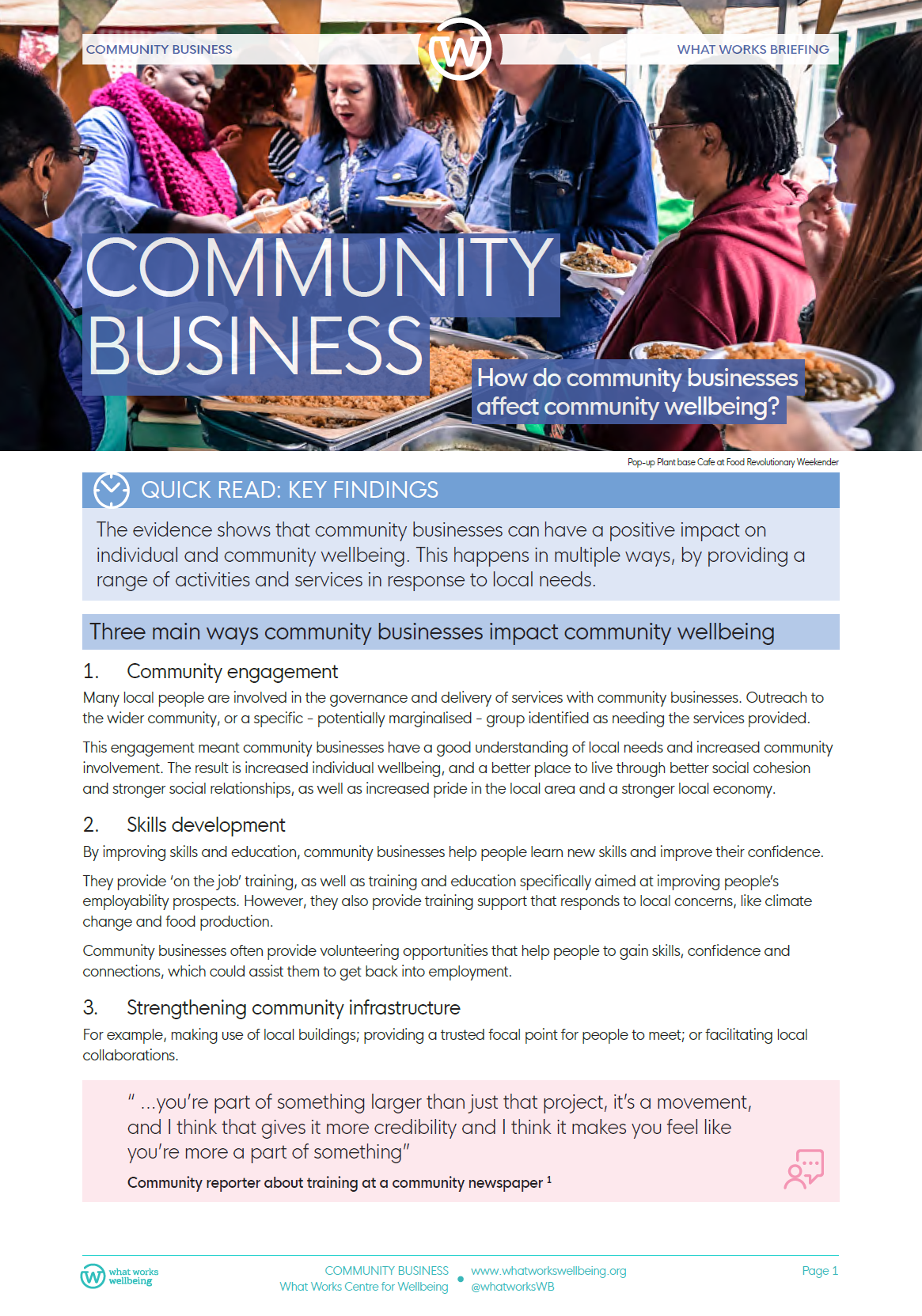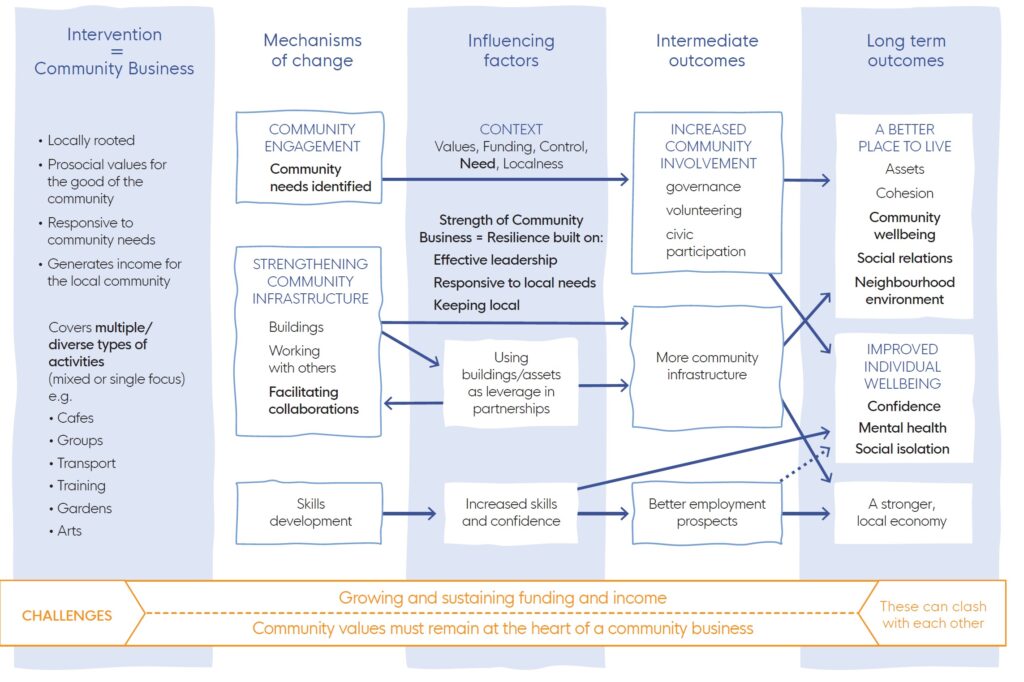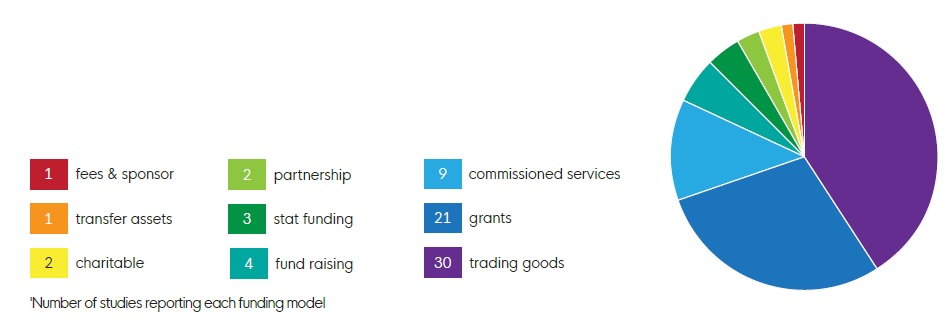Community business

Quick read: key findings
The evidence shows that community businesses can have a positive impact on individual and community wellbeing. This happens in multiple ways, by providing a range of activities and services in response to local needs.
How do community businesses affect community wellbeing?
- Three main ways community businesses impact community wellbeing
Community engagement
Many local people are involved in the governance and delivery of services with community businesses. Outreach to the wider community, or a specific – potentially marginalised – group identified as needing the services provided. This engagement meant community businesses have a good understanding of local needs and increased community involvement. The result is increased individual wellbeing, and a better place to live through better social cohesion and stronger social relationships, as well as increased pride in the local area and a stronger local economy. - Skills development
By improving skills and education, community businesses help people learn new skills and improve their confidence. They provide ‘on the job’ training, as well as training and education specifically aimed at improving people’s employability prospects. However, they also provide training support that responds to local concerns, like climate
change and food production.Community businesses often provide volunteering opportunities that help people to gain skills, confidence and connections, which could assist them to get back into employment. - Strengthening community infrastructure
For example, making use of local buildings; providing a trusted focal point for people to meet; or facilitating local collaborations.
you’re part of something larger than just that project, it’s a movement, and I think that gives it more credibility and I think it makes you feel like you’re more a part of something”
Community reporter about training at a community newspaper
How community businesses achieve wellbeing outcomes
The following model shows the impact community businesses have on community wellbeing. It highlights how those impacts are achieved, and what risks can impact them.
The themes highlighted in bold represent those mechanisms, influencing factors or outcomes for which there is strong or promising evidence.

Three areas of potential risk for effective delivery and impact
The review found a number of risks that could stop community businesses from having a positive impact:
- Difficulty recruiting or managing staff and volunteers.
- Lack of experience or skills needed to manage assets, and the financial risks involved in asset transfer.
- Lack of available funding appropriate to the needs of the business; as well as conflicts between the available funds and the original values of the community business.
Definitions
Community wellbeing
Community wellbeing ‘is the combination of social, economic, environmental, cultural, and political conditions identified by individuals and their communities as essential for them to flourish and fulfil their potential.’ From this 2008 study by Wiseman and Brasher (page 358).
Community businesses
- Are locally rooted.
- Trade for the benefit of the local community.
- Are accountable to the local community
- Have broad community impact.
The big idea
At the end of 2019, there were 9,000 community businesses in England, with a combined total income of £890m. The sector employs 33,900 paid staff and 205,600 volunteers.
This briefing – and the full review it is based on – looks at the ways community businesses make an impact on the wellbeing of their customers, staff, volunteers, and local communities. It also reveals the existing evidence on what community businesses can do to improve their impact. The review does not look at outcomes relating to health care services, social care services and use of these services.
Of the 43 studies included, 32 are based here in the UK, making the findings very relevant for practitioners in this country.
-
17706
studies examined
-
43
included
-
32
based in the UK
Community business and activities
Most community businesses report undertaking a number of activities,
rather than focusing on just one.
Activities delivered by community businesses include: Employment, education and training related activities (16 studies), Health and social care related activities (16 studies), Shops, cafés and pubs (22 studies), Sport and leisure related activities (15 studies), Community hubs (12 studies), Commercial property/space letting (12 studies), Food – catering and producing (9 studies), Housing (7 studies), Craft, industry and production (8 studies), Arts centres (6 studies), Environment and nature (6 studies), Transport (5 studies), Libraries (3 studies), Childcare provision by
community organisations (6 studies), Energy (4 studies), Finance (3 studies), Village halls (1 study).
Most community businesses had more than one source of funding. The sources of funding reported by community businesses include:

What evidence did we find?
Where you see the following symbols it indicates:
-
qualitative
-
quantitative
-
strongWe can be confident that the evidence can be used to inform decisions.
-
promisingWe have moderate confidence. Decision makers may wish to incorporate further information to inform decisions.
-
initialWe have low confidence. Decision makers may wish to incorporate further information to inform decisions.
Local communities reported positive impacts of community businesses’ services on community wellbeing, community involvement, neighbourhood
environment, and reduced social isolation.
Local communities were positive about the impact of community businesses’ services on social relationships and connections.
Community businesses have a positive impact on social cohesion, civic participation and individual wellbeing.
Community businesses have a positive impacts on quality of life, health, mental health, employment and volunteering of people in the community.
Balancing the need to become financially sustainable and seek diverse sources of funding, with the need to stay true to the original values of
the community business.
What makes a strong and resilient community business?
Community businesses are very diverse, operate under different models, access a range of funding and support, and offer a huge variety of activities arising and responding to local needs. Because of this diversity, we couldn’t identify a set of specific conditions that apply to community businesses in general.
The qualitative analysis does show that the following factors have the most potential to influence resilience of a community business:
- Effective leadership. Including the ability to listen to and advocate for local people, but also to act when opinions are divided. One study described ‘the need for a [leader] with passionate vision, an entrepreneurial approach, perseverance and long term commitment’
- Size and localness. One study showed smaller, focused, community transport schemes felt closer to the community than more ambitious, staffed initiatives. Another study in the Highlands highlighted the
importance of a shop assistant who could speak to
customers in their preferred language. - Understanding local needs and responding to them. For example, food-growing community business which helped local families in disadvantaged areas eat healthily during the school holidays. Another study identified community shops as particularly responsive to local needs, stating that ‘they were frequently described as ‘lifelines’ by their participants, enabling older residents to stay in the village and to play a more active role in community life at the same time.’
Evidence into action
In order to support community businesses in creating wellbeing impacts for
their communities:
Community businesses
If you are an established community business, or are thinking of starting one, ask yourself these questions to see how you can use the evidence to have the biggest impact:
- Are you encouraging local people to get involved and helping them make a meaningful contribution to your business? This could be by becoming volunteers, trustees or partners; or by helping you plan or deliver your activities.
- Do you offer opportunities for people to develop new skills? The evidence shows that this is a key way community businesses make a difference to staff, volunteers, local people and the economy.
- Are you making the most of local assets and relationships? Community businesses can strengthen local infrastructure by considering use of buildings and other valued spaces and by collaborating with other local organisations, if it is feasible.
- Are you putting resources into improving how volunteers are recruited, retained and supported, particularly if you
are located in an area of deprivation?
Funders and commissioners
- Create clear and accessible routes for community businesses to obtain funding, particularly enterprise development support. This helps groups to trade as part of their business model before they take on an asset or
service. For example, providing a start-up grant and paid-for support to help groups to focus on the right aspects of sustainability for the start of their community business journey. - Have realistic expectations about the length of time and resources required for a community business to become sustainable.
- Increase resources to improve how volunteers are recruited, retained and supported, particularly in areas of deprivation where finding volunteers can be hard.
Local Authorities and Voluntary and Community Sector Infrastructure Organisations
- Facilitate and support the asset transfer and ownership process – and help community businesses consider whether it is feasible for them and, if so, to find the right model.
- Broker connections between community businesses and non-sector volunteers and leaders. This could make a difference by strengthening leadership; improving succession planning; and reducing staff burnout.
Evidence gaps and recommendations for further research
- Better quality evaluations for community businesses, what they do, and what works for whom. These should include some counterfactual comparison where possible (for quantitative study designs), and repeated measurements.
- More research is needed on how skills-building, leadership, and employment practices affect community wellbeing outcomes for community businesses.
- More than half of included studies came from grey literature searchers. This shows the importance of looking to policy and practice for relevant evidence, and going beyond electronic database searches.
- Better reporting of methods in studies. In this review, the methods were not clearly reported in most included studies. This affects the confidence we can place in the findings.
- Studies on community businesses without a physical hub. There is a need for primary research into these types of community businesses, for example those trading solely online.
Downloads
You may also wish to read the blog article on this document.
Downloads
You may also wish to read the blog article on this document.
![]()
[gravityform id=1 title=true description=true ajax=true tabindex=49]



